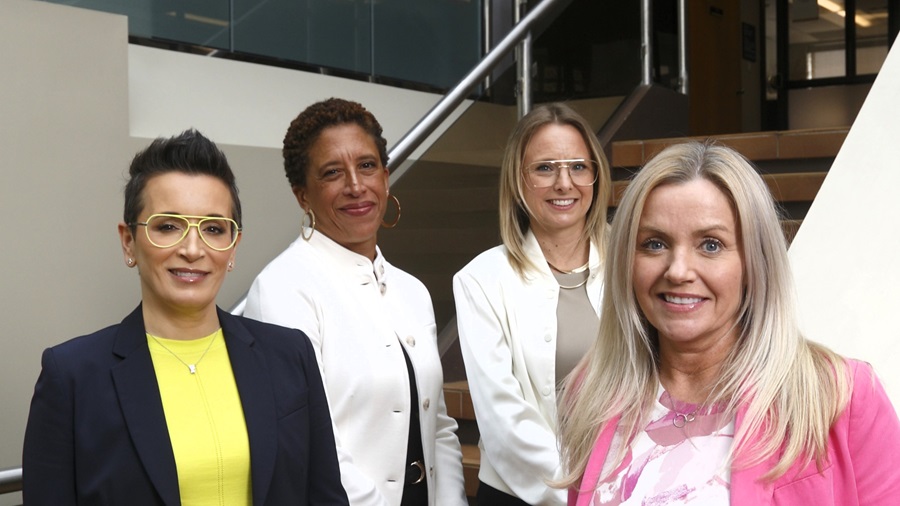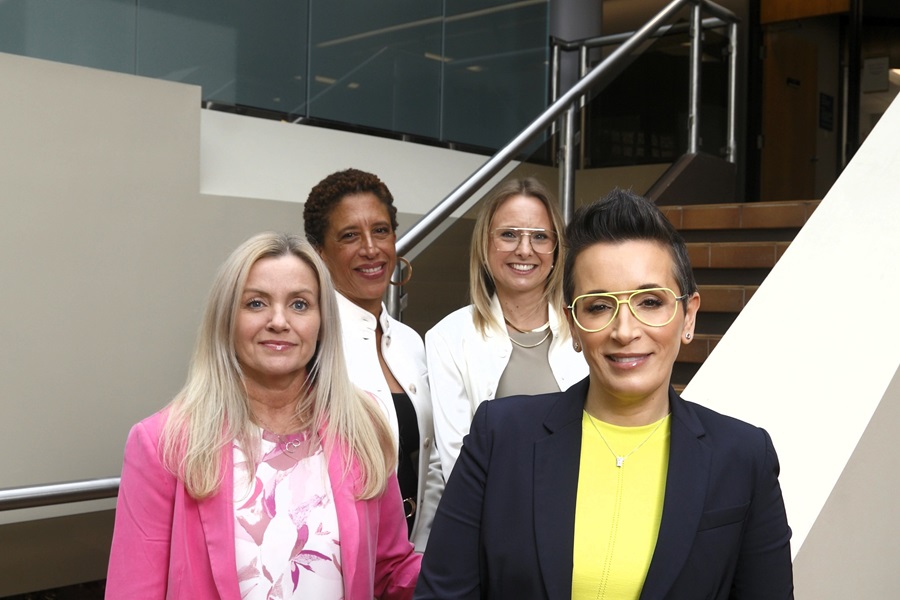Women lead here
How female leadership is elevating the city’s communications and public relations game
Photo (from left): Cheryl Weedmark, Patricia Hoffer, Liisa Sheldrick and Tania Testa
MANAGING REPUTATION, IMAGE and brand through corporate communications or public relations is a realm dominated by women. But when it comes to who holds the top position in those departments or agencies, it is often men who rise to the top.
Click here to view this story in magazine format
Except, it seems — at this moment in time — here in London.
At the international level, the Global Women in PR’s Annual Index for 2022 report states: “The boardroom continues to be dominated by men (64 per cent), despite the global industry being two-thirds female.” Here in Canada, the prevalence of women in the field is closer to half with about 53 per cent of the sector being female, according to Statistics Canada’s 2023 census data.
Story Continues Below
While there seems to be no statistics on the gender balance of leadership in Canadian communications roles, in the United States, a KPMG study called Mind the Gap: Women’s Leadership in Public Relations, conducted in 2019, asserts that up to 80 per cent of the top public relations agencies are headed by men.
But let’s consider who leads the comms shops at most of the major public sector organizations in London. Western University, the City of London, London Hydro, London Police Service and more, are all led by women. And many of the major London-based private sector companies’ communications functions are also led by women.
Trying to nail down why this is the case is like wearing a blindfold while trying to thread a needle — it is elusive, to say the least. In speaking with four of London’s female communications leaders, there are, however, some common traits that emerge in leadership styles, the role of mentors, the experience they bring to the table and giving back.
These four women — Tania Testa, London Health Sciences Centre’s corporate communications and public engagement executive; Patricia Hoffer, chief communications officer at St. Joseph’s Healthcare London; Liisa Sheldrick, global corporate communications director at Solventum (formerly 3M Healthcare); and Cheryl Weedmark, corporate communications lead for the Thames Valley District School Board (TVDSB) — all bring a wealth of varying experience to their positions.

After beginning her communications career in industries that included education and economic development, Hoffer had an 11-year career with boutique firm Lashbrook Marketing & Public Relations (before merging with marketing firm RedRhino in 2019, Lashbrook Marketing was operated for almost 30 years by distinguished local PR and marketing specialist Laurie Lashbrook, who now heads up communications at Ivey Business School).
“At Lashbrook, the focus was very much on healthcare and community development — so a very non-profit, public-sector focus,” explains Hoffer, noting that her experience at Lashbrook helped her to establish a network of healthcare and business contacts, something communicators count as one of their most important assets. “London is a very hard town to break into and you know — and I’ll be honest — when I first came to London, I didn’t think it would last very long.”
Like Hoffer at Lashbrook Marketing, Testa and Sheldrick both worked for another of the city’s influential marketing icons, Robin Honey at Honey Design (it merged with Arcane Digital in 2014), where they were afforded the opportunity to build influential networks across various sectors.
“We have a really great pipeline of women in communications and a talent pool in this city that many organizations benefit from,” says Sheldrick, who spent the first decade of her career in Toronto before returning to her hometown. “I can point to so many strong, strong women leaders whom I’ve worked with and learned from over the years that I’ve been back in London.”
Story Continues Below
Having female mentorship early in their careers seems to have played an important role for these women. “I’ve had male and female leaders over my career, and I’d say that the experience that I had with female leadership was pretty different for me,” Testa explains. “They were the ones who talked to me about what I wanted to do and where I wanted to go but also, at the same time, asked me how I was doing.”
Testa also credits a female leader with providing her with invaluable career advice: “She told me that my days should be comprised of listening more than I’m speaking — and to remember to ask the question, ‘why.’ Why is this like that or why are we doing that or why can’t it be different?”
For Sheldrick, one of the most important pieces of early advice she received was to focus on meaningful tasks and not to shoulder the burden of “office housework” and low-value assignments — often the invisible hurdle to gender equality in the workplace. “[That meant] to be very selective about doing the work I wanted to be doing, which I think was a good foreshadow to some of the articles you see these days about women and their corporate domestic work,” she says.
“I think there’s a lot to celebrate in London and I think that there are many, many women who have built a legacy for all of us to follow here,” Sheldrick adds.

Weedmark also points to the many strong female role models London has seen over the years, and not just in communications. “There’s just so many names that come to mind and I think we’re fortunate to have those — mentors and role models who have paved the way for a lot of us to make it a little bit less challenging to be in these leadership roles.”
The third area these four leaders have in common is their approach to leadership. Empathetic leadership — identifying with others and taking a genuine interest in their point of view — and creating strong teams are at the core for each.
“There’s an old saying, that if you want to go fast, go alone. And if you want to go far, go together,” notes Sheldrick. “And I think that vulnerability and the ability to articulate a strategy, a goal, a mission, a vision, ultimately allows you to go farther together.”
Testa, whose résumé includes time at Trojan Technologies, TVDSB and Western University, points to the opportunity to shape great teams as one of the most rewarding aspects of her career. It’s been “a pleasure and a privilege that has been a common thread throughout my career,” she explains. “I’ve been able to come in as a team of one or two and then build around me to be the team that the organization needs.”
Story Continues Below
Having the opportunity to team-build and provide others with the opportunity to flourish is something that resonates with each of leaders. “Leadership, from where I sit, is not about having all the answers. It’s really about creating experiences so that others on the team can help find those answers themselves,” says Weedmark. “It’s literally what just makes this the best job — seeing the team members be successful and seeing them accomplish things and seeing them grow.”
Hoffer agrees. “My approach to leadership is to create an environment where team members can thrive, do their best work and [want to] kick off the covers in the morning,” she says. Hoffer also says it’s crucial for women to claim their seat at the table. “We work very hard to get that seat as women, particular for me as a woman of colour. But then once you get there, it’s what you do with it and how you use your voice that really matters.”
Commitment to community and giving back is another thing these women have in common. For some, that is through volunteering efforts and for others it is shepherding in the next generation of communicators.
After 26 years in London, Hoffer is most proud of her ability to offer a helping hand to others. “I have the connections to be able to give back from the perspective of opening doors for people,” she says. “I never turned down an informational interview. I never turned down an opportunity to connect somebody whether it be a student, a newcomer, somebody trying to find their way in the field or somebody thinking about a career change. I believe that we have to share that knowledge and that expertise.”
Whether it is giving back to the community or profession, leading from a place of empathy, or having strong mentors, it is difficult to pinpoint the reason why so many women have risen to the top communications positions in London. But, as Testa sums up, it is a noteworthy period. “It is a cool moment in time and has created a pretty interesting picture.” ![]() Roxanne Beaubien
Roxanne Beaubien

